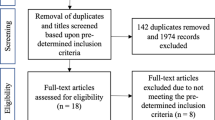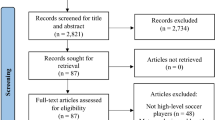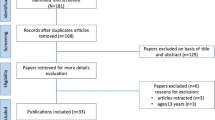Abstract
Background and aim
Strength and power are crucial components to excelling in all contact sports; and understanding how a player’s strength and power levels fluctuate in response to various resistance training loads is of great interest, as it will inevitably dictate the loading parameters throughout a competitive season. This is a systematic review of training, maintenance and detraining studies, focusing on the development, retention and decay rates of strength and power measures in elite rugby union, rugby league and American football players.
Search strategies
A literature search using MEDLINE, EBSCO Host, Google Scholar, IngentaConnect, Ovid LWW, ProQuest Central, ScienceDirect Journals, SPORTDiscus™ and Wiley InterScience was conducted. References were also identified from other review articles and relevant textbooks. From 300 articles, 27 met the inclusion criteria and were retained for further analysis.
Study quality
Study quality was assessed via a modified 20-point scale created to evaluate research conducted in athletic-based training environments. The mean ± standard deviation (SD) quality rating of the included studies was 16.2 ± 1.9; the rating system revealed that the quality of future studies can be improved by randomly allocating subjects to training groups, providing greater description and detail of the interventions, and including control groups where possible.
Data analysis
Percent change, effect size (ES = [Post-Xmean − Pre-Xmean)/Pre-SD) calculations and SDs were used to assess the magnitude and spread of strength and power changes in the included studies. The studies were grouped according to (1) mean intensity relative volume (IRV = sets × repetitions × intensity; (2) weekly training frequency per muscle group; and (3) detraining duration. IRV is the product of the number of sets, repetitions and intensity performed during a training set and session. The effects of weekly training frequencies were assessed by normalizing the percent change values to represent the weekly changes in strength and power. During the IRV analysis, the percent change values were normalized to represent the percent change per training session. The long-term periodized training effects (12, 24 and 48 months) on strength and power were also investigated.
Results
Across the 27 studies (n = 1,015), 234 percent change and 230 ES calculations were performed. IRVs of 11–30 (i.e. 3–6 sets of 4–10 repetitions at 74–88 % one-repetition maximum [1RM]) elicited strength and power increases of 0.42 % and 0.07 % per training session, respectively. The following weekly strength changes were observed for two, three and four training sessions per muscle region/week: 0.9 %, 1.8 % and 1.3 %, respectively. Similarly, the weekly power changes for two, three and four training sessions per muscle group/week were 0.1 %, 0.3 % and 0.7 %, respectively. Mean decreases of 14.5 % (ES = −0.64) and 0.4 (ES = −0.10) were observed in strength and power across mean detraining periods of 7.2 ± 5.8 and 7.6 ± 5.1 weeks, respectively. The long-term training studies found strength increases of 7.1 ± 1.0 % (ES = 0.55), 8.5 ± 3.3 % (ES = 0.81) and 12.5 ± 6.8 % (ES = 1.39) over 12, 24 and 48 months, respectively; they also found power increases of 14.6 % (ES = 1.30) and 12.2 % (ES = 1.06) at 24 and 48 months.
Conclusion
Based on current findings, training frequencies of two to four resistance training sessions per muscle group/week can be prescribed to develop upper and lower body strength and power. IRVs ranging from 11 to 30 (i.e. 3–6 sets of 4–10 repetitions of 70–88 % 1RM) can be prescribed in a periodized manner to retain power and develop strength in the upper and lower body. Strength levels can be maintained for up to 3 weeks of detraining, but decay rates will increase thereafter (i.e. 5–16 weeks). The effect of explosive-ballistic training and detraining on pure power development and decay in elite rugby and American football players remain inconclusive. The long-term effects of periodized resistance training programmes on strength and power seem to follow the law of diminishing returns, as training exposure increases beyond 12–24 months, adaptation rates are reduced.





Similar content being viewed by others
References
Baechle T, Earle R. Essentials of strength training and conditioning. 2nd ed. Champaign: Human Kinetics; 2000.
Fleck SJ, Kraemer WJ. Designing resistance training programs. 3rd ed. Champaign: Human Kinetics; 2004.
Stone M, Stone M, Sands W. Principles and practice of resistance training. Champaign: Human Kinetics; 2007.
Baker D, Nance S, Moore M. The load that maximizes the average mechanical power output during jump squats in power-trained athletes. J Strength Cond Res. 2001;15(1):92–7.
Baker DG, Newton RU. Adaptations in upper-body maximal strength and power output resulting from long-term resistance training in experienced strength-power athletes. J Strength Cond Res. 2006;20(3):541–6.
Berger R. Optimum repetitions for the development of strength. Res Quart. 1963;33:334–8.
Stone MH, O’Bryant H, Garhammer J. A hypothetical model for strength training. J Sports Med Phys Fitness. 1981;21(4):342–51.
Tan B. Manipulating resistance training program variables to optimize maximum strength in men: a review. J Strength Cond Res. 1999;13(3):289–304.
Fleck S. Detraining: its effects on endurance and strength. Nat Strength Cond J. 1994;22–28.
Hakkinen K. Neuromuscular adaptation during strength training, aging, detraining and immobilization. Phys Rehab Med. 1994;6(3):161–98.
Komi PV. Strength and power in sport. 2nd ed. London: Blackwell; 2002.
Burton A. Muscle plasticity: response to training and detraining. J Physiother. 2002;88(7):398–408.
Folland J, Williams A. The adaptations to strength training: morphological and neurological contributions to increased strength. Sports Med. 2007;37(2):145–68.
Fry AC. The role of resistance exercise intensity on muscle fibre adaptations. Sports Med. 2004;34(10):663–79.
Blazevich AJ, Sharp NC. Understanding muscle architectural adaptation: macro and micro level research. Cells Tissues Organs. 2005;181:1–10.
Blazevich AJ, Gill ND, Zhou S. Intra- and intermuscular variation in human quadriceps femoris architecture assessed in vivo. J Anat. 2006;209(3):289–310.
Mujika I, Padilla S. Muscular characteristics of detraining in humans. Med Sci Sports Exerc. 2001;33(8):1297–303.
Larsson L, Ansved T. Effects of long-term physical training and detraining on enzyme histochemical and functional skeletal muscle characteristic in man. Muscle Nerve. 1985;8(8):714–22.
Komi PV. Training of muscle strength and power: interaction of neuromotoric, hypertrophic, and mechanical factors. Int J Sports Med. 1986;7(Suppl. 1):10–5.
Leveritt M, Abernethy PJ, Barry BK, et al. Concurrent strength and endurance training: a review. Sports Med. 1999;28(6):413–27.
Aagaard P. Training-induced changes in neural function. Exerc Sport Sci Rev. 2003;31(2):61–7.
Cronin J, Sleivert G. Challenges in understanding the influence of maximal power training on improving athletic performance. Sports Med. 2005;35(3):213–34.
Peterson MD, Rhea MR, Alvar BA. Applications of the dose-response for muscular strength development: a review of meta-analytic efficacy and reliability for designing training prescription. J Strength Cond Res. 2005;19(4):950–8.
Muller E. Influence of training and of inactivity on muscle strength. Arc Phys Med Rehab. 1970;51:449–62.
Mujika I, Padilla S. Detraining: loss of training-induced physiological and performance adaptations. Part I: short term insufficient training stimulus. Sports Med. 2000;30(2):79–87.
Rhea MR, Alvar BA, Burkett LN, et al. A meta-analysis to determine the dose response for strength development. Med Sci Sports Exerc. 2003;35(3):456–64.
Wernbom M, Augustsson J, Thomee R. The influence of frequency, intensity, volume and mode of strength training on whole muscle cross-sectional area in humans. Sports Med. 2007;37(3):225–64.
Cormie P, McGuigan M, Newton R. Developing maximal neuromuscular power part 2 - training considerations for improving maximal power production. Sports Med. 2011;41(2):125–46.
Issurin V. Block periodization versus traditional training theory: a review. J Sports Med Phys Fitness. 2008;48(1):65–75.
Cormie P, McGuigan MR, Newton RU. Developing maximal neuromuscular power. Part 1: biological basis of maximal power production. Sports Med. 2011;41(1):17–38.
Newton R. Expression and development of maximal muscle power (thesis). Lismore: Southern Cross University; 1997.
Ebben W. Complex training: brief review. J Sports Sci Med. 2002;1:42–6.
Fleck S. Periodized strength training: a critical review. J Strength Cond Res. 1999;13(1):82–9.
Lieber RL, Friden J. Functional and clinical significance of skeletal muscle architecture. Muscle Nerve. 2000;23(11):1647–66.
Kawakami Y. The effects of strength training on muscle architecture in humans. Int J Sport Health Sci. 2005;3:208–17.
Schoenfeld BJ. The mechanisms of muscle hypertrophy and their application to resistance training. J Strength Cond Res. 2010;24(10):2857–72.
Rhea MR. Determining the magnitude of treatment effects in strength training research through the use of the effect size. J Strength Cond Res. 2004;18(4):918–20.
Zatsiorsky V, Kraemer W. Science and practice of strength training. 2nd ed. Champaign: Human Kinetics; 1995.
O’hagan F, Sale D, MacDougall J. Comparative effectiveness of accommodating and weight resistance training modes. Med Sci Sports Exerc. 1995;27:1210–9.
Wilmore J, Costill D, Kennedy L. Physiology of sport and exercise. 4th ed. Champaign: Human Kinetics; 2008.
Brughelli M, Cronin J, Levin G, et al. Understanding change of direction ability in sport: a review of resistance training studies. Sports Med. 2008;38(12):1045–63.
Gay R. A comparison of four strength maintenance programs for football players (thesis). Waco: Texas Technological College; 1969.
Argus CK, Gill N, Keogh J, et al. Effects of a short-term pre-season training programme on the body composition and anaerobic performance of professional rugby union players. J Sports Sci. 2010;28(6):679–86.
Argus CK, Gill ND, Keogh JW, et al. Changes in strength, power, and steroid hormones during a professional rugby union competition. J Strength Cond Res. 2009;23(5):1583–92.
Baker D. The effects of an in-season of concurrent training on the maintenance of maximal strength and power in professional and college aged rugby league football players. J Strength Cond Res. 2001;15(2):172–7.
Brechue WF, Mayhew JL. Upper-body work capacity and 1RM prediction are unaltered by increasing muscular strength in college football players. J Strength Cond Res. 2009;23(9):2477–86.
Chilibeck PD, Magnus C, Anderson M. Effect of in-season creatine supplementation on body composition and performance in rugby union football players. App Physiol Nut Metab. 2007;32(6):1052–7.
Coutts A, Reaburn P, Piva T, et al. Changes in selected biochemical, muscular strength, power and endurance measures during deliberate overreaching and tapering in rugby league players. Int J Sports Med. 2007;28(2):116–24.
Coutts AJ, Murphy AJ, Dascombe BJ. Effect of direct supervision of a strength coach on measures of muscular strength and power in young rugby league players. J Strength Cond Res. 2004;18(2):316–23.
Gabbett T. Performance changes following a field conditioning program in junior and senior rugby league players. J Strength Cond Res. 2006;20(1):215–21.
Gabbett T. Skill-based conditioning games as an alternative to traditional conditioning for rugby league players. J Strength Cond Res. 2006;20(2):309–15.
Ghigiarelli J, Nagle E, Gross F, Robertson R, Irrgang J, Myslinski T. The effects of a 7-wk heavy elastic band and weight chain program of upper body strength and upper body power in a sample of division 1-AA football players. J Strength Cond Res. 2009;23(3):756–64.
Hoffman J, Cooper J, Wendell M, et al. Comparison of Olympic vs traditional power lifting training programs in football players. J Strength Cond Res. 2004;18(1):129–35.
Hoffman J, Kraemer W, Fry A, et al. The effects of self-selection for frequency of training in a winter conditioning program for football. J App Sport Sci Res. 1990;4(3):76–82.
Hoffman J, Ratamess N, Klatt M, et al. Comparison between different off-season resistance training programs in division III American college football players. J Strength Cond Res. 2009;23(1):11–9.
Hoffman JR, Kang J. Strength changes during an in-season resistance-training program for football. J Strength Cond Res. 2003;17(1):109–14.
Hoffman JR, Ratamess NA, Cooper JJ, et al. Comparison of loaded and unloaded jump squat training on strength/power performance in college football players. J Strength Cond Res. 2005;19(4):810–5.
Hortobagyi T, Houmard JA, Stevenson JR, et al. The effects of detraining on power athletes. Med Sci Sports Exerc. 1993;25(8):929–35.
Jones K, Hunter G, Fleisig G, et al. The effects of compensatory acceleration on upper-body strength and power in collegiate football players. J Strength Cond Res. 1999;13(2):99–105.
Legg D, Burnham R. In-season shoulder abduction strength changes in football players. J Strength Cond Res. 1999;13(4):381–3.
O’Connor D, Crowe M. Effects of six weeks of B-hydroxy-B-methylbutyrate (HMB) and HMB/creatine supplementation on strength, power and anthropometry of highly trained athletes. J Strength Cond Res. 2008;21(2):419–23.
Rogerson S, Riches CJ, Jennings C, et al. The effect of five weeks of Tribulus terrestris supplementation on muscle strength and body composition during preseason training in elite rugby league players. J Strength Cond Res. 2007;21(2):348–53.
Schneider V, Arnold B, Martin K, et al. Detraining effects in college football players during the competitive season. J Strength Cond Res. 1998;12(1):42–5.
Stone M, Sanborn K, Smith L, et al. Effects of in-season (5 weeks) creatine and pyruvate supplementation on anaerobic performance and body composition in American football players. Int J Sport Nut. 1999;9:146–65.
Wenzel R, Perfetto E. The effect of speed versus non-speed training in power development. J App Sport Sci Res. 1992;6(2):82–7.
Babault N, Cometti G, Bernardin M, et al. Effects of electromyostimulation training on muscle strength and power of elite rugby players. J Strength Cond Res. 2007;21(2):431–7.
Appleby B, Newton RU, Cormie P. Changes in strength over a 2-year period in professional rugby union players. J Strength Cond Res. 2012;26(9):2538–46.
Baker D, Newton R. Methods to increase the effectiveness of maximal power training for the upper body. Strength Cond J. 2005;27(6):24–32.
Baker D, Newton R. Change in power output across a high-repetition set of bench throws and jump squats in highly trained athletes. J Strength Cond Res. 2007;21(4):1007–11.
Jones K, Bishop P, Hunter G, et al. The effects of varying resistance-training loads on intermediate- and high-velocity-specific adaptations. J Strength Cond Res. 2001;15(3):349–56.
Kaneko M, Fuchimoto T, Togji H, et al. Training effects of different loads on the force velocity relationship and mechanical power output in human muscle. Scand J Sport Sci. 1993;5:50–5.
McBride J, Triplett-McBride T, Davie A, et al. The effect of heavy vs. light-load jump squats on the development of strength, power and speed. J Strength Cond Res. 2002;16:75–82.
Poprawski B. Aspects of strength, power and speed in shot put training. New Stud Ath. 1988;3:89–93.
Schmidtbleicher M. Training for power events. In: Komi PV, editor. Strength and power in sport. London: Blackwell Science; 1994. p. 381–95.
Wilson G, Newton R, Murphy A, et al. The optimal training load for the development of dynamic athletic performance. Med Sci Sports Exerc. 1993;25(11):1279–86.
Wisloff U, Costagna C, Helgerud J, et al. Strong correlation of maximal squat strength with sprint performance and vertical jump height in elite soccer players. Brit J Sports Med. 2004;38:285–8.
Hakkinen K, Allen M, Komi PV. Changes in isometric force- and relaxation-time, electromyographic and muscle fiber characteristics of human skeletal muscle during strength training and detraining. Acta Physiol Scand. 1985;125:573–85.
Cronin J, Crewther B. Training volume and strength and power development. J Sci Med Sport. 2004;7(2):144–55.
Enoka R. Neuromechanical basis of kinesiology. Champaign: Human Kinetics; 1994.
McLester J, Bishop P, Gulliams M. Comparison of 1 day and 3 days per week of equal-volume resistance training in experienced subjects. J Strength Cond Res. 2000;14:273–81.
Carroll T, Abernethy P, Logan P, et al. Resistance training frequency: strength and myosin heavy chain responses to two and three bouts per week. Eur J App Physiol. 1998;78(3):270–5.
Gillam G. Effects of frequency of weight training on muscle strength enhancement. J Sports Med. 1981;21:432–6.
Caldwell BP, Peters DM. Seasonal variation in physiological fitness of a semiprofessional soccer team. J Strength Cond Res. 2009;23(5):1370–7.
Izquierdo M, Ibanez J, Gonzalez-Badillo JJ, et al. Detraining and tapering effects on hormonal responses and strength performance. J Strength Cond Res. 2007;21(3):768–75.
Marques MC, Tillaar R, Vescovi JD, et al. Changes in strength and power performance in elite senior female professional volleyball players during the in-season: a case study. J Strength Cond Res. 2008;22(4):1147–55.
Mihalik JP, Libby JJ, Battaglini CL, et al. Comparing short-term complex and compound training programs on vertical jump height and power output. J Strength Cond Res. 2008;22(1):47–53.
Mujika I, Santisteban J, Castagna C. In-season effect of short-term sprint and power training programs on elite junior soccer players. J Strength Cond Res. 2009;23(9):2581–7.
Newton RU, Rogers RA, Volek JS, et al. Four weeks of optimal load ballistic resistance training at the end of season attenuates declining jump performance of women volleyball players. J Strength Cond Res. 2006;20(4):955–61.
Stone MH, Sands WA, Pierce KC, et al. Power and power potentiation among strength-power athletes: preliminary study. Int J Sports Phyiol Perform. 2008;3(1):55–67.
Vingren JL, Kraemer WJ, Ratamess NA, et al. Testosterone physiology in resistance exercise and training: the up-stream regulatory elements. Sports Med. 2010;40(12):1037–53.
Issurin V, editor. Block periodization as an alternative approach to preparation of high-performance canoe/kayak paddlers. Warsaw: Coaches’ Symposium International Canoe Federation, 2009.
Gibala MJ, MacDougall JD, Sale DG. The effects of tapering on strength performance in trained athletes. Int J Sports Med. 1994;15(8):492–7.
Hoffman JR, Fry A, Howard R, et al. Strength, speed and endurance changes during the course of a division I basketball season. J App Sport Sci Res. 1991;5(3):144–9.
Marques MC, Gonzalez-Badillo JJ. In-season resistance training and detraining in professional team handball players. J Strength Cond Res. 2006;20(3):563–71.
Hakkinen K. Changes in physical fitness profile in female volleyball players during the competitive season. J Sports Med Phys Fitness. 1993;33(3):223–32.
McGuigan MR, Cormack S, Newton RU. Long-term power performance of elite Australian rules football players. J Strength Cond Res. 2009;23(1):26–32.
Cronin JB, Hansen KT. Strength and power predictors of sports speed. J Strength Cond Res. 2005;19(2):349–57.
Moher D, Liberati A, Tetzlaff J, et al. Preferred reporting items for systematic reviews and meta-analyses. The PRISMA Group. PLoS Med. 2009;6(6):e1000097.
Author information
Authors and Affiliations
Corresponding author
Rights and permissions
About this article
Cite this article
McMaster, D.T., Gill, N., Cronin, J. et al. The Development, Retention and Decay Rates of Strength and Power in Elite Rugby Union, Rugby League and American Football. Sports Med 43, 367–384 (2013). https://doi.org/10.1007/s40279-013-0031-3
Published:
Issue Date:
DOI: https://doi.org/10.1007/s40279-013-0031-3




